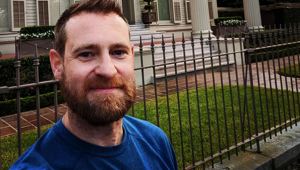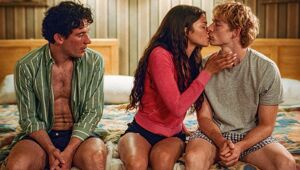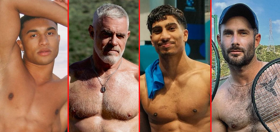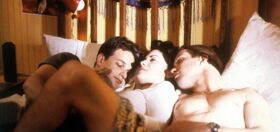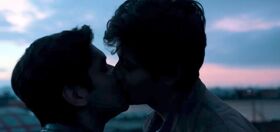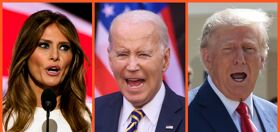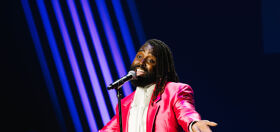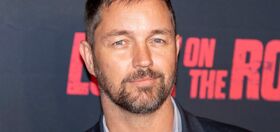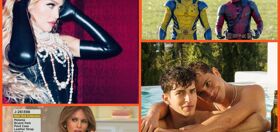
For Jonathan Butterell, the road to the big screen also happened to lead back home.
Butterell cut his showbiz teeth as a dancer and choreographer, leaving behind his native Sheffield, England for the lights of London. He didn’t have to look far to find brilliant collaborators, as he trained in dance under the tutelage of Matthew Bourne (of the all-male Swan Lake fame), and began choreographing for future Oscar-winner Sam Mendes. Opportunities to direct and choreograph followed, with Butterell moving to Broadway to choreograph Nine, Fiddler on the Roof, and The Light in the Piazza. A chance viewing of a documentary about a teen drag queen inspired Butterell to begin development on a new musical with Dan Gillespie Sells and Tom MacRae at the tiny Crucible Theatre back in Sheffield. That show became Everybody’s Talking About Jamie.
Now Butterell brings his baby to the big screen. Everyone’s Talking About Jamie follows the titular 16-year-old (played by newcomer Max Harwood), a blue-collar kid aspiring to become a drag performer. His interest in the art form leads him to Hugo (Richard E. Grant), a middle-aged queen who passes on some tips for becoming a drag star…along with some history of the queer community. Jamie also plans to show off his new drag-o-riffic look at his senior prom…if his teachers and the school bully don’t stop him first.
We caught up with Butterell just ahead of the much-anticipated release of the movie. Everybody’s Talking About Jamie arrives on Amazon September 17.
How about we take this to the next level?
Our newsletter is like a refreshing cocktail (or mocktail) of LGBTQ+ entertainment and pop culture, served up with a side of eye-candy.
Congratulations on your first movie.
It’s a crazy thing.
So this has been a long road from the Crucible Theatre to here. How do you feel that your baby has grown up?
It’s hard to wrap my head around in many ways. I’ve been around the block a bit; I’m not a kid. If you would have told me when we started this process that this is where we’d finish up, I’d say you were crazy. But on some other level, the power of this story has its own life. I saw this documentary Drag Queen at 16 that went in. It literally just went in. And I thought I need to continue this story. And I continued it in the medium I knew well: to create a musical about it.

Sure.
I felt it naturally sung. Then, from the Crucible Theatre in Sheffield—which is my home town, a community I knew well. Remember, this was an unknown story for them. At the beginning, we hadn’t even sold many tickets. We had an open dress rehearsal in which people paid one pound to come see it. At that dress rehearsal, something happened in the audience, and went [click] like that. From that moment in time, we sold out. Warp Films, who actually had an office in Sheffield literally across the valley, not very far from the theatre, came to see the stage show. They rang me and said they wanted the rights to make a movie. That was on week two of our run.
That’s incredible. Wild.
Wild.
Were you offered the director’s chair right away then?
I was never not offered it. There was never a moment they suggested anyone else to direct. So I just kept going, and nobody told me not to.
That’s an amazing attitude, though you’d never directed a film before. Obviously, directing a film is very different from doing a stage show. Did you ever have a moment of self-doubt?
Every day of the shoot.
[Laughter]
Every day of the shoot. But I think that every creative has that conversation with himself. It felt like such a responsibility. I felt like I had enough transferable skill to take what I already knew from theatre in terms of holding a space, holding a group of people. I also felt I had the most amazing team of people around me. Chris Ross, our DOP. Jane Levick, our production designer. Guy Speranza, our costume designer. Nadia Stacey, our make-up designer. So I knew that I had the best people around me. I felt like I had a thousand hands on my back telling me you can do it. But I also felt the freedom to be able to lead and say “This is a vision. This is what I think it should be.”
Sure.
Even from the execs. I think I pushed the vision so far the budget started to grow, but they followed me. And I’m grateful for it.

Tell me more about that. Directing film is very different from directing stage. How did your approach to the material change?
I was liberated. I really went this is the chance to let my imagination explode. I’m very visual. I could see it. I could visualize it. I knew the community, the city really well. I knew the vista really well. I knew the world really well. And I knew the inner world of the character well. The wonderful thing about film is the close-up—getting in and seeing the inner workings of a character. Film does that like nothing else can do. The power and delicacy and strength of what’s going on beyond somebody’s eyes—I love exploring that. I love what the camera can do with that. I love the scale of the camera. And I learned, in post, to love to edit. Detail by detail, the moment you cut. Three frames can make a difference.
Indeed.
I adored the whole process. It felt very natural to me. Not that it wasn’t terrifying—I was terrified every day. But there’s nobody out there, when given this responsibility, won’t have imposter syndrome. But I needed to tell the story. That fueled me.
That’s fantastic. You speak of the visuals. You use a lot of pink and blue imagery in Jamie’s songs.
We call it Jamie pink, Jamie blue.
Is that deliberate—to suggest gender fluidity?
Totally. I wanted to create a world in which nothing was binary in a sense. Jamie is a cisgender, gay man. That’s his story. But I didn’t want anything to land in a binary place, and that’s with all the characters. I feel like we’ve lived in this world of such entrenchment for a long time. One argument against another. One way of life against another way of life. I just wanted to step out of that. I’ve been speaking to a few people that call the character Dean a bully.
Right.
I never call him a bully. I call him a d*ck. Because he is! He’s a stupid d*ck.
[Laughter]
He says stupid things, but he’s more complex than just the role of bully. In the same way, I didn’t want to assign Jamie into the role of victim that we’ve seen a thousand times. Jamie, in this movie, was never going to be the victim. I wanted him to be strong with who he was. He’s openly gay, he has no problem with that. His mom gives him a pair of shoes in essentially the second scene and says “Go for it.” The things that Jamie overcomes are some of the doubts he had inside. Some of that doubt was put in by his dad. Some of that doubt as a 16-year-old man—particularly in the second song of the film—he takes responsibility. He knows he’s responsible for creating some of those thoughts and needing to step out of that thought pattern. It’s that complex non-binary story I wanted to tell. And even his dad: I didn’t want to make him an evil dad that turned on his son.

You’re also using an untested lead in Max Harwood. Does that affect the way you direct him—his lack of experience?
I love working with young people. I work with young people both on stage and in the community as well. I work for two charities that work with young people. So taking a young actor, I found beautiful. I find they teach you as much as you teach them. They bring such freshness. And Max is super bright, super intelligent. He had many things naturally to him, but also an innate sense of what the camera is doing. He just knew. The same with Lauren who plays Pritti. She’d never acted before. Max had some training. Lauren had none at all.
Wow.
She brought something so innately honest. You can’t buy that, particularly on film. It’s going to capture it, even if you’re not conscious of it. I just loved working with those two. And actually, most of the young people in the film had never acted before. They’re straight out of school.
You’re also personally connected to the material. I realize you didn’t write the show, that it’s based on a true story. I don’t know how you identify—
Oh, I’m a gay guy.
Glad to have you in the family. But being a kid in Sheffield, you obviously loved to perform. You went on to become a very successful dancer and choreographer. And I couldn’t find your age online…
I’m going to keep it that way!
But I’m guessing based on your body of work—which begins in the 90s—you remember the AIDS crisis.
I was there. I was there at those marches. I lost close friends during that time. And I was a young man just arriving in London experiencing that. It felt really important—that generational exchange. That passing on was really important to me.

It shows in that beautiful number Hugo/Richard Grant has. John McCrea, the original Jamie, also cameos there.
Absolutely. He plays young Hugo.
So even though this is a true story, how much of you is Jamie? How much of you is Hugo?
[Long pause]
Quite a lot. I was a young, queer kid from Sheffield who, when I was that age, wanted to get out of Sheffield. I wanted to escape. School was tough for me—very tough, tougher than for Jamie. But I never wanted to be a victim. I got that strength from the love of my mother and father. But the part of me that wanted to get out—that took me to London and eventually New York.
That’s inspiring.
Jamie’s story—he does what I did in many ways. In his little journey, he comes to a sense of himself on a Monday morning after all that experience of coming out and going to his prom. He puts the [trash] bins out on a Monday morning in his own fabulousness. I feel like I’ve returned now with this piece to Sheffield. This is my love letter to Sheffield, and it’s my version of putting the bins out.
Last question then. So, you’ve shepherded this project all the way from concept to movie, every step of the way. How has it changed you? How has it pushed you as an artist?
It challenged me at every stage. I never used to call myself an artist.
No?
It was a really difficult word to call myself, probably because of my background, my own story. It felt like a big word. As the politics of the world changed and shifted not long ago, I claimed that word for myself. I said, “This is an important word.” I have power. My artistry is my voice and my vision. It’s important that I give voice to where I’m coming from. If I can shift the world in any small way, I have to own my artistry. I think this has just made me more courageous. I want to make more movies. I want to tell stories. This makes me want it even more. I think of all the things I’ve done—and I’ve done the most amazing things and worked with amazing people—something as simple as Jamie has shifted me massively. It’s a simple story. The power in the telling of that is what I need to hold onto for myself.
Everybody’s Talking About Jamie arrives on Amazon September 17.


